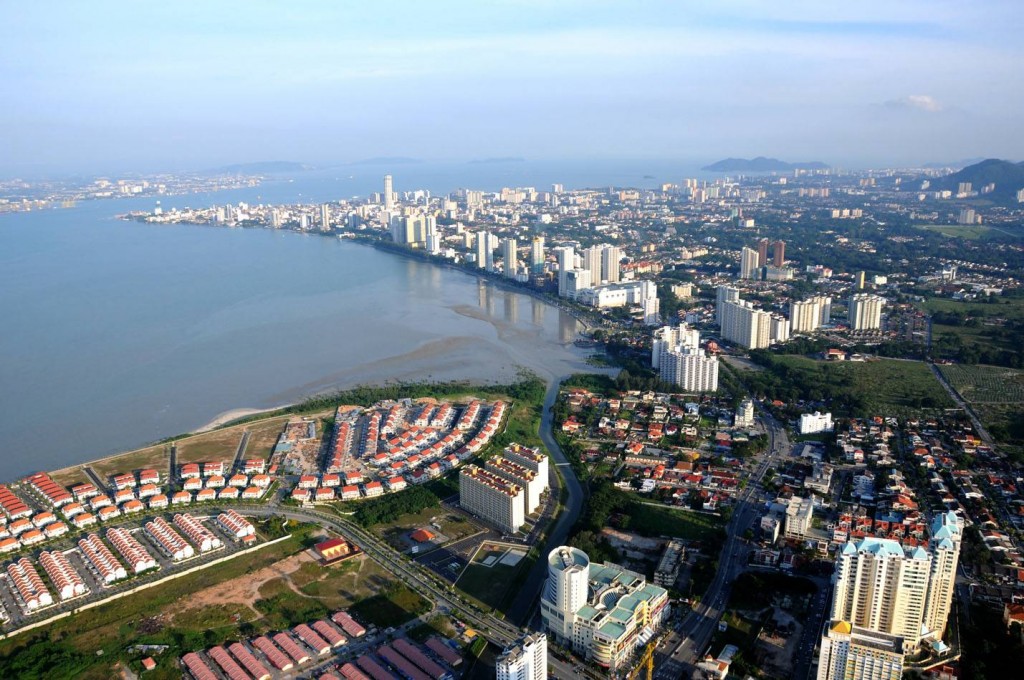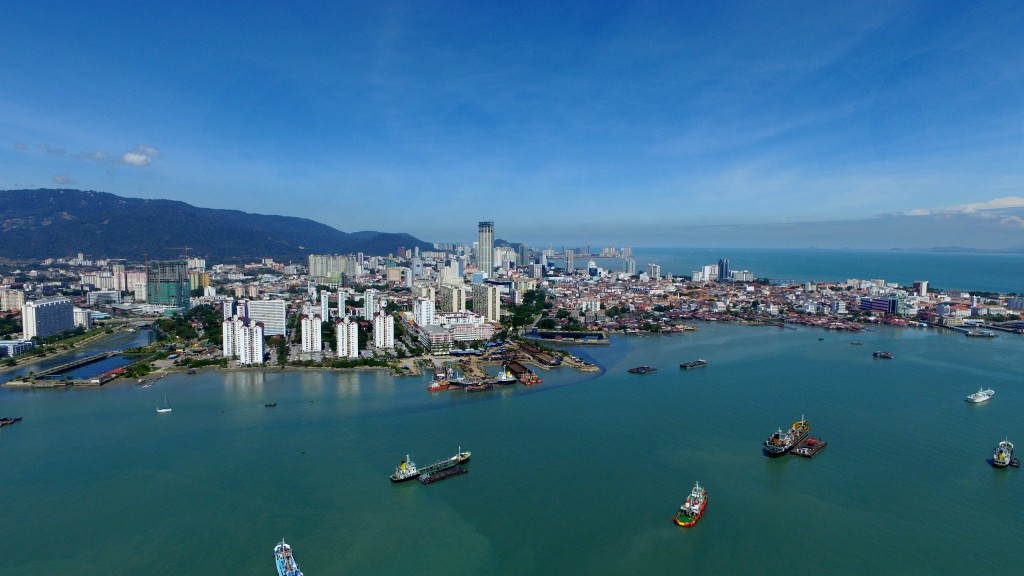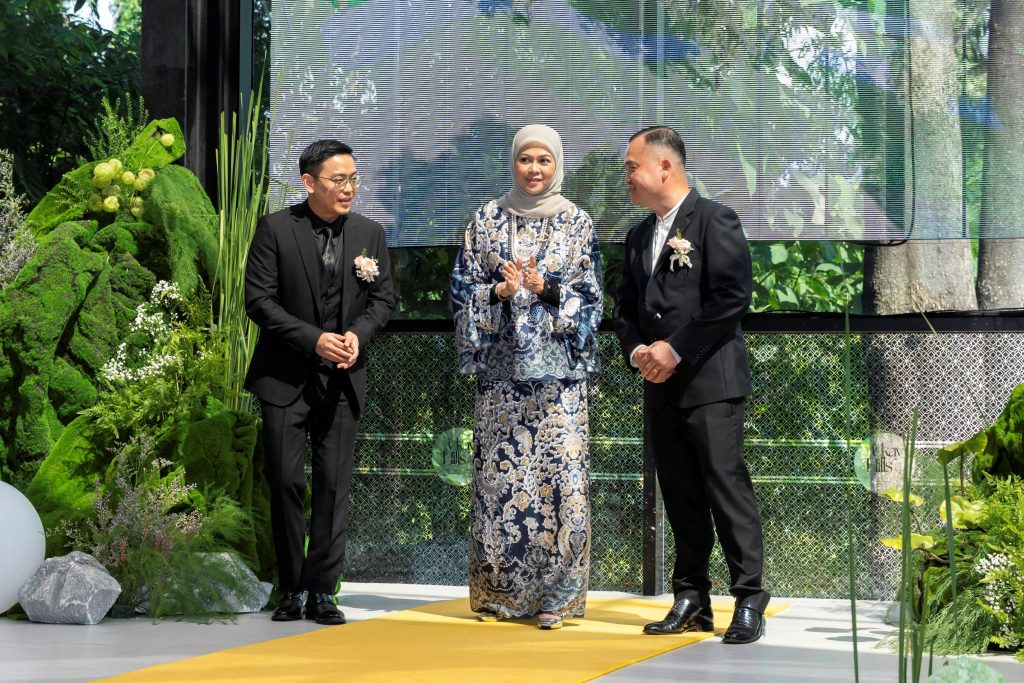Contributed by Joshua Lee
Penang comprises an island and a slice of the coast along the Malacca Straits – and the state is arguably one of the most developed in Malaysia
Penang Island is said to have been first documented by Chinese sailors of the Ming dynasty in the 15th century. At that time, Emperor Yongle launched naval expeditions that would eventually reach all the way to eastern Africa. The legendary Chinese Admiral, Zheng He, led the treasure fleets and apparently encountered Penang island – then known as Bīnláng Yù (in Chinese: 梹榔屿).

The mythical footprint of the legendary Admiral Zheng He, surrounded by a rock enclosure in the temple hall at the Sam Poh Tong Footprint Temple in Batu Maung, Penang.
Beyond the early encounters with the famed treasure fleets, the history of modern Penang was largely shaped by British colonialism in the late-eighteenth century – when the British East India Company acquired Penang Island and a foothold on the peninsula at Perai from an embattled Sultanate of Kedah.
As with Singapore and Malacca, the trade concerns of the East India Company led to Penang’s state capital, George Town, becoming a free port – and an important stronghold to bolster the Company’s influence in the Malacca Straits.

One of George Town's oldest buildings, the 19th century Penang Town Hall. Photo by Amirul Amri on Unsplash.
George Town is a remarkable example of a historic colonial town demonstrating a succession of cultural influences. Stemming from its former function as a trading port linking the Eastern and Western hemispheres, Penang has inherited the culture of Great Britain, Europe, the Malay Archipelago, India, and China. This trade history of almost 500 years creates a unique cultural blend represented in its architecture and people.
As one of the most complete surviving historical city centres, and in light of its storied past, George Town was designated a UNESCO World Heritage Site in 2008. This designation further boosted Penang’s status as a tourist destination and reinforced the state’s reputation as a bastion of rich cultural heritage.
In 2010, George Town was ranked as the most liveable city in Malaysia by ECA International, coming in at eighth place within Asia as well. Also, Penang has recorded the highest amount of Foreign Direct Investments in Malaysia, attracting RM12.2 billion, or 26% of Malaysia’s total investments.
In terms of property investment, as is widely known, property prices are subject to the law of supply and demand – and real estate prices in Penang are among the highest in the country.
With a land area of 1,048 square kilometres, and a resident population of 1.7 million, Penang is one of Malaysia’s most densely populated states at 1,720 people per square kilometre – after Kuala Lumpur, where every square kilometre is home to an average of 7,328 individuals, and the federal territory of Putrajaya, which boasts a population density of 2,118 per square kilometre.

The view of Penang island and Butterworth as seen from a plane. The line connecting both sides is the Penang Bridge.
Given its long history and high population density, Penang is definitely a great location for property investment. Land scarcity is one of the key factors driving both property rental prices and property values.
Penang properties do not just serve the local population, as the state embodies great potential for tourists as well – many heritage houses have been turned into AirBnb homes for tourists, serving both the local and foreign tourist markets.
With Malaysia’s Visit Malaysia 2020 campaign, Prime Minister Tun Dr Mahathir Mohamed set a target of 30 million international tourist arrivals next year. The focus of the campaign is on eco-tourism, arts, and culture.
Penang state exco for Tourism Development, Arts, Culture, and Heritage, Yeoh Soon Hin has affirmed that Penang plays a very important role in helping its nation meet its target of 30 million tourists in the Year 2020.
One of the most interesting facts to note is that out of the RM84.1 billion in overall tourism receipts in 2018, expenditures by Chinese tourists’ made up about 15% (RM12.3 billion) of total tourism revenue.

Tourists from China posing for a picture in front of Georgetown's Yap Kongsi temple on Armenian Street. Image by Kwong Wah Yit Poh.
In 2018, 2.9 million tourists visited Malaysia from China. According to the Chinese Ambassador to Malaysia, Bai Tian, an estimated 3.5 million tourists from China are expected to fly into Malaysia in 2019 – an increase of nearly 20%.
Singapore is another country from which a large number of tourists visit Malaysia. In 2018, a total of 10 million Singaporeans visited Malaysia as tourists, spending around RM27.26 billion – amounting to about 30% of Malaysia’s total tourism revenue in 2018.

The 'mother' float leading the procession during the Noordin Street Tow Moo Keong procession of Nine Emperors Gods which began at the Tow Moo Keong Temple on Noordin Street. Image by Lim Beng Tatt.
These tourists are mostly ethnic Chinese (76% of Singapore’s population identify as Chinese). If the tourist arrival numbers for both Singapore and China are combined, the number of tourists amount to more than 50% of total tourist arrivals in Malaysia.
Based on this fact, as property investors, we should focus our efforts on where the money flows. If we know that there is money that flows into the tourism sector, and the main target segments are predominately ethnic Chinese – then Penang, with its rich Chinese heritage culture, is one of the easily identifiable property hotspots that we should be investing in.
Penang has been declared a food paradise and one of the best food cities in Asia by Thrillist and Culture Trip – Forbes considers Penang as one of the top 10 cities to visit for street food.
As part of the CHI Triangle investment model, any location with great food tends to be flooded with people too – which promises great rental opportunities. Focusing on properties around known food havens would be a good bet to look for real estate gems.
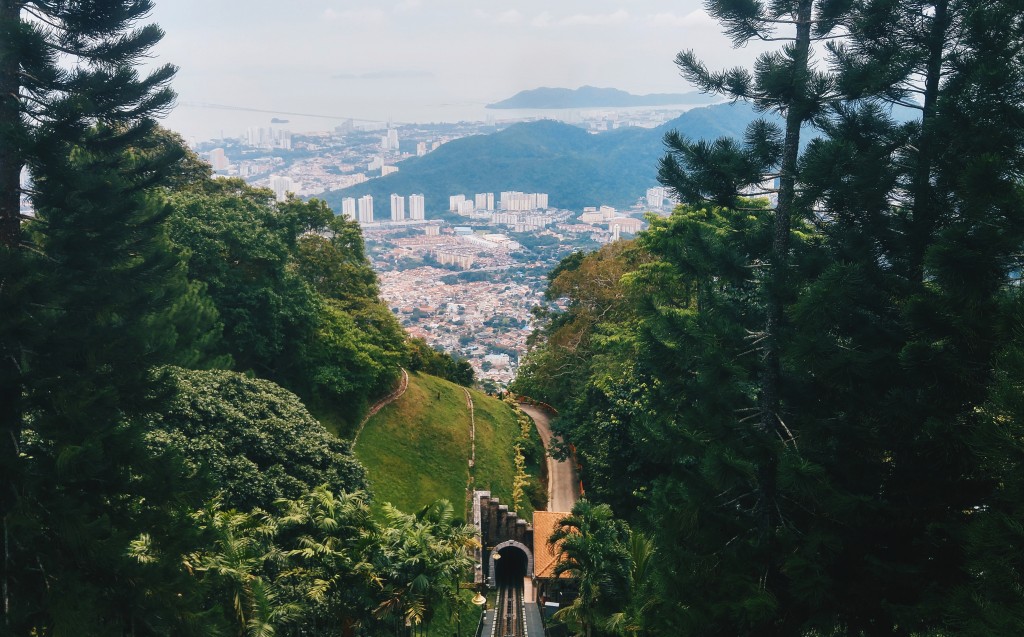
Photo by Fidelia Zheng on Unsplash.
In 2016, George Town was rated as the most attractive destinations for commercial property investment in Malaysia by Knight Frank, surpassing even Kuala Lumpur. Statistics show that beach hotels in Penang tend to have higher occupancy rates (around 70%) compared to city hotels (at 55%).
Other than being recognised by UNESCO as a World Heritage Site, Penang is also favoured for its hotels, leisure facilities, and healthcare institutions – Penang is also known as the leading medical tourism destination in Malaysia.
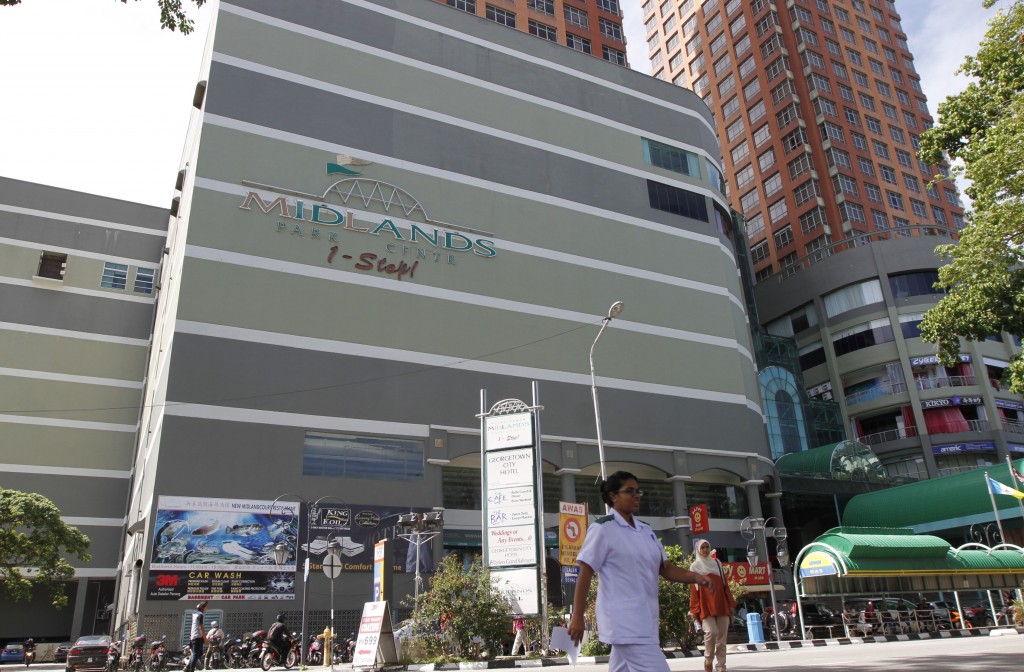
The Midlands Park One-stop mall has been turned into another “home-stay”. The top floor units tend to be rented out to outstation patients. Quite a lot of hotels have also mushroomed near hospitals now to accommodate medical tourism.
Since Penang is flourishing with tourism, commercial properties remain as one of the best investment opportunities we can look into. Look out for commercial opportunities around the famous landmarks and monuments such as Cheong Fatt Tze Mansion (The Blue Mansion), Kek Lok Si Temple, Kuan Yin Temple, Snake Temple, the Clock Tower, and also KOMTAR (Kompleks Tun Abdul Razak).
If you can’t afford a commercial property right now, do look into heritage houses or high-rises that can be converted into AirBnB units, to take advantage of Penang’s reputation as a place of rich cultural heritage.
CHI Triangle's model entails the study of human traffic and populations flows. CHI Triangle focuses its property research on the aspect of the human element – your target tenant. In a heritage location, you may find many supporting properties within a vicinity of three kilometres, where they can help to ensure a good investment and provide a viable return on investment for you as a landlord. As investors, we provide housing solutions to our niche market, and we hope to be rewarded handsomely.
To get to know more about Joshua Lee’s property investment live workshop for free, you may register at www.chitriangle.com or you may get in touch with Joshua Lee on Facebook and Twitter (@coachjoshualee).
Stay ahead of the crowd and enjoy fresh insights on real estate, property development, and lifestyle trends when you subscribe to our newsletter and follow us on social media.

